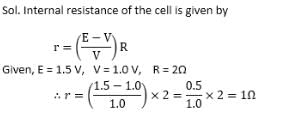Test : Physics - 1 - NDA MCQ
20 Questions MCQ Test - Test : Physics - 1
The escape velocity for a body of mass 1 kg from the Earth surface is 11.2 kms-1. The escape velocity for a body of mass 100 kg would be
If the temperature inside a room is increased, the relative humidity will
A cell has an emf 1.5 V. When connected across an external resistance of 2 Ω, the terminal potential difference falls to 1.0 V. The internal resistance of the cell is
There is the following relation between the velocity (v) and time (t) of a particle:
v = 20 + 0.1 t² The particle is—
The plot given below represent displacement S of a particle with time-t. The particle is

When light passes from one medium to another, the physical quantity that remains unchanged is
For which of the following substances, the resistance decreases with increases in temperature?
A particle has initial velocity (3i ̂+4j ̂) and has acceleration (0.4i ̂+0.3j ̂ ). Its speed after 10 s is
When a mass is rotating in a plane about a fixed point, its angular momentum is directed along
A solid sphere of radius R is placed on a smooth horizontal surface. A horizontal force F is applied at height h from the lowest point. For the maximum acceleration of the Centre of mass



















